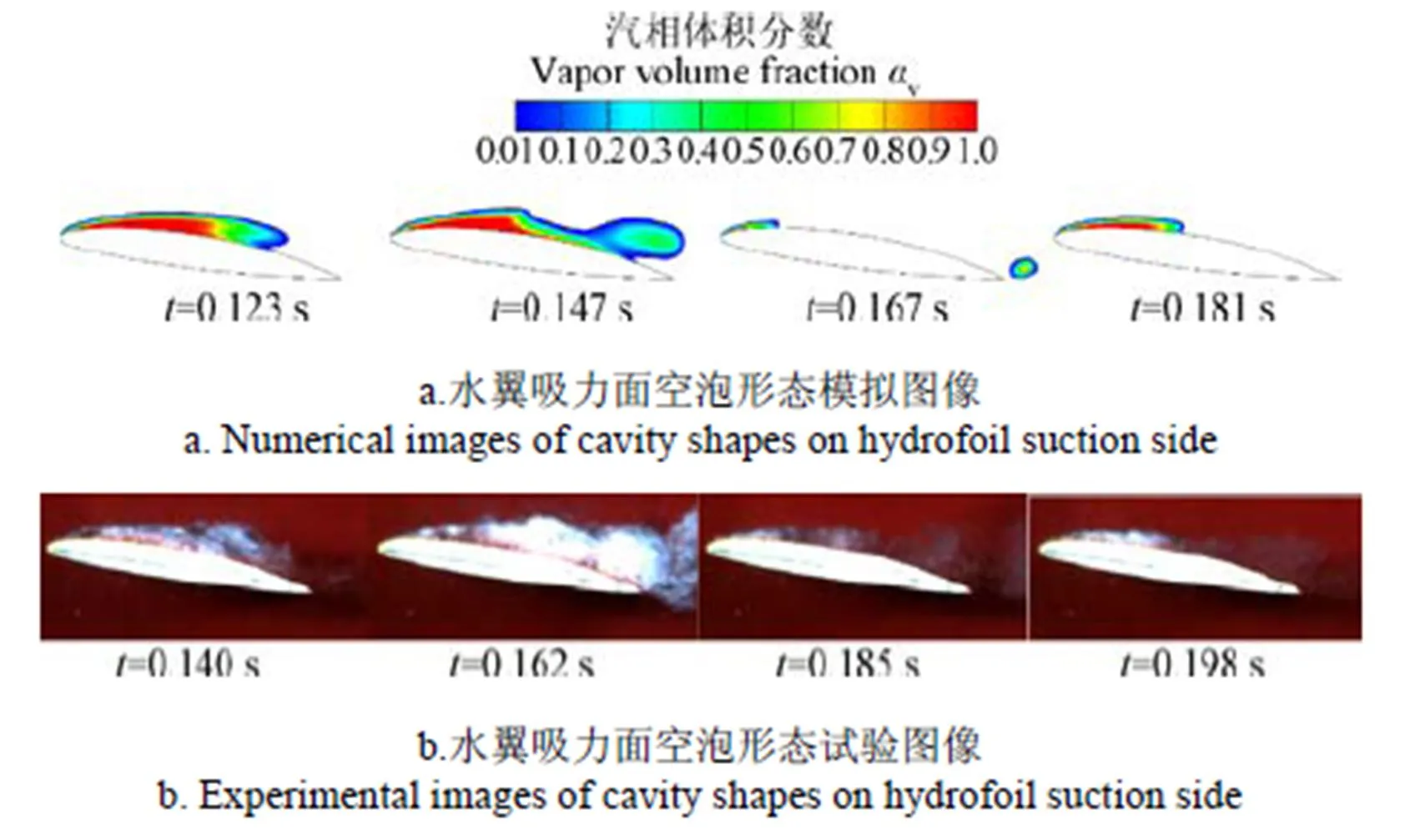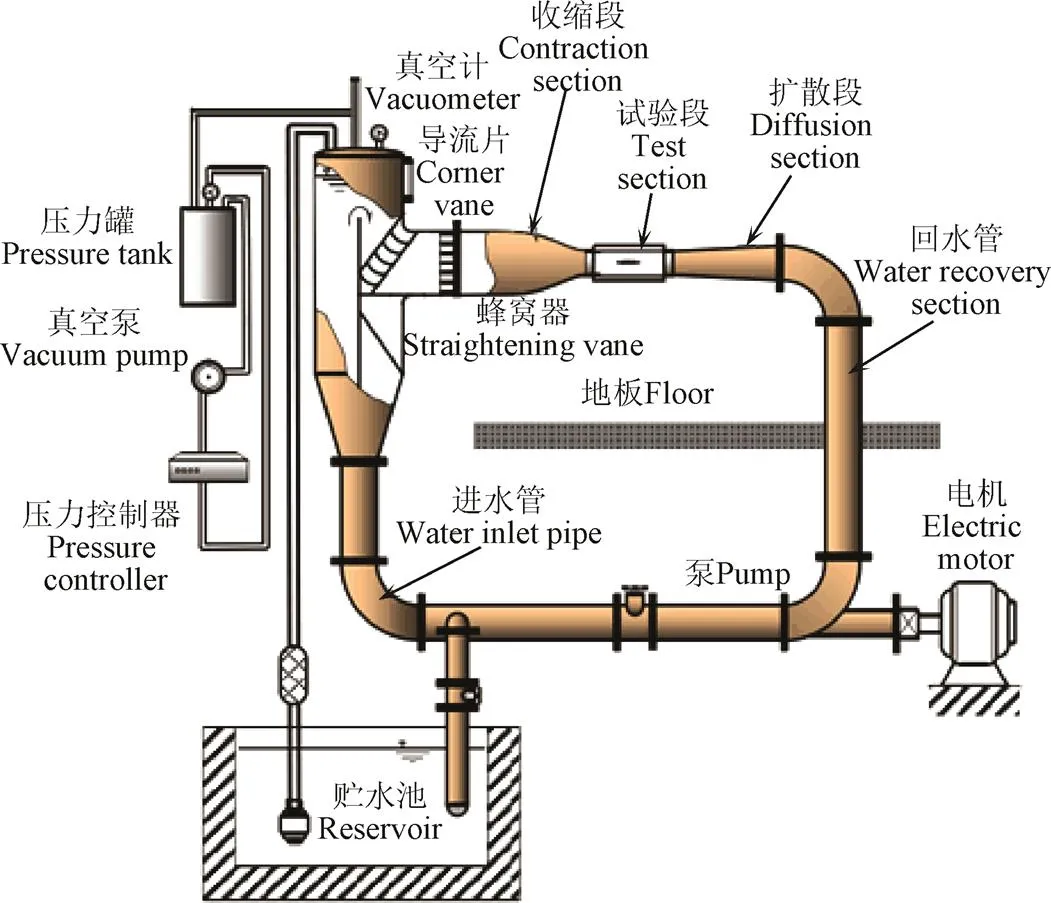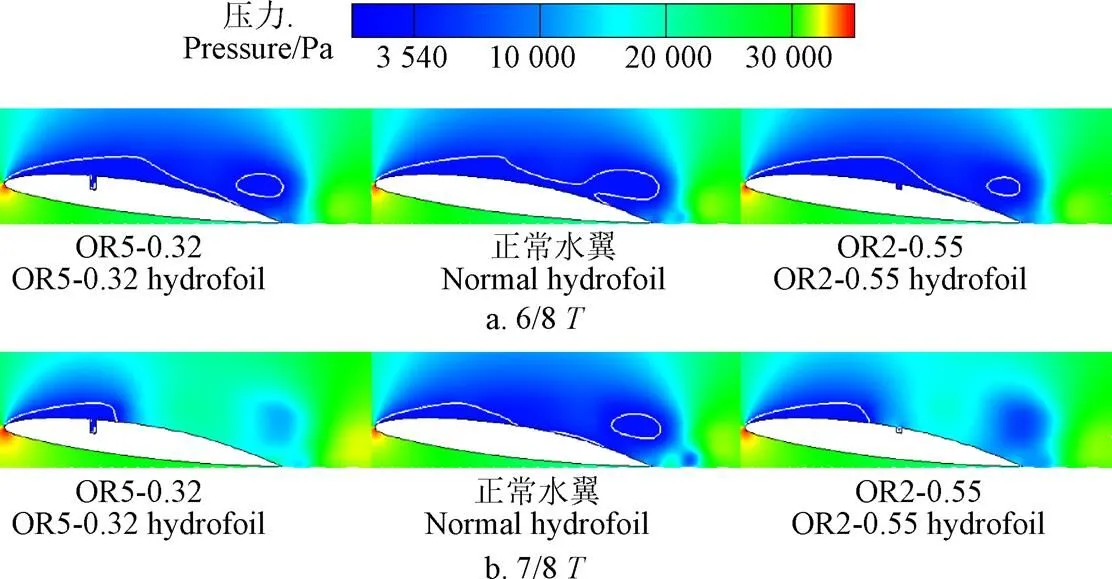水翼吸力面布置凹槽抑制空化研究
王 巍,唐 滔,卢盛鹏,焦建雄,张庆典,王晓放
水翼吸力面布置凹槽抑制空化研究
王 巍,唐 滔,卢盛鹏,焦建雄,张庆典,王晓放
(大连理工大学海洋能源利用与节能教育部重点实验室,大连 116024)
空化引起不同程度振动、冲击和噪声,加剧物体表面空蚀,使结构提早发生疲劳。为有效抑制和延缓空化发生和空泡脱落,该文提出了在水翼吸力面布置凹槽的方法,旨在通过水翼表面结构的改变来实现空化流动的调节。在数值模拟研究中,采用Realizable湍流模型和Schnerr-Sauer空化模型,围绕8°攻角下NACA66 (MOD)水翼,开展不同空化数、凹槽尺度和凹槽位置对二维水翼空化流场的动力学特性研究,并进一步分析了水翼表面特殊结构抑制空化的机理。结果表明:当片空化发生时,凹槽布置在距水翼前缘0.32弦长位置时,能降低空泡振荡频率,提高水翼水动力性能;当云空化发生时,适当的凹槽表面构型能够使水翼吸力面边界层变薄,边界层分离点滞后,水翼尾缘回流区减薄,吸力面低压区减小,证明了凹槽表面构型对空化抑制的适用性。然而,在水翼吸力面布置凹槽,虽然可以降低水翼表面边界层的厚度,增强抗逆压能力,但却触发了凹槽附近区域回射流的加速。因此,只有当抗逆压梯度能力大于回射流冲击时,才可以实现对空化流动的抑制。该研究成果扩大了空化流动的被动控制方法研究范围,为水力机械空化抑制技术提供了参考。
空化;计算机仿真;模型;水翼;吸力面凹槽;空化抑制;水动力性能
0 引 言
局部空化和脱落的非稳态特征在高可靠性的核主泵、水力透平叶片和船用螺旋桨中受到极大关注。特别是伴随大尺度空泡脱落的云空化的发生,严重影响着水力性能,引起水力机械不同程度的振动、冲击和噪声,空泡流的低频振荡和大规模的空泡云脱落会加剧物体表面的空蚀,使结构提早发生疲劳破坏,对于高速运动物体会影响其控制稳定性,甚至导致灾难性的颤振和动力学失稳[1-3]。
延缓空泡的发生和抑制空泡的脱落一直以来是水力机械研究的重点和难点课题。国内外众多学者从空化发展和空化导致非稳态机理方面做了大量的科学研究,认为反向压力梯度形成的回射流是造成片空化脱落、云空化产生的主要原因[4-10]。王巍等[11]研究还发现回射流及其强度是空化体形态改变的重要因素,并定义了描述回射流强度的特征数,用其来判断空泡体的类型。因此,控制回射流在一定程度上可以实现对云空化的控制。
按照有无外界能量的输入,把控制空化流动的方法分为主动控制与被动控制[12-14]。对于主动控制技术, Mikhail等[15]通过试验研究壁面切向喷射对空化的影响,发现低速喷射可以有效减轻空化效应,而高速喷射可以减少能量损失,提高流动的水动力学品质,其试验研究还证明实施流量控制在某些条件下能够很好的调节空化流场。Wang等[16-17]研究发现在水翼表面射流可以有效阻挡回射流从水翼尾部向水翼头部的运动,使得空泡发展和脱落现象明显减弱,有效抑制了片空化发展、片空化向云空化的转变以及云空化的发展。对于被动控制技术,其通过无外部能量注入的装置来改变流体的压力和速度分布以控制流动。Zhang等[18]研究了平板水翼布置障碍物对于云空化的影响。Kadivar等[19]提出在水翼表面布置汽泡发生器,能够显著减小吸力面低压区面,有效抑制空化的发展。邬伟等[20]通过在水翼吸力面上设置微小方形凸起,并提出设置拱弧的新方案来抑制空化。
在延缓和抑制云空化的研究中,无论采用主动控制还是被动控制,在一定程度上都起到了抑制空化的目的。然而,当表面射流水翼或叶片处于旋转状态时,由于空心叶片内部流体的复杂流动,空心叶片强度的下降等原因,会给整个转子系统的稳定运行带来不确定性因素。而采用水翼表面布置障碍物,抑制空化的效果并不能随着空化条件的变化而进行相应的调控,且在无空化时,障碍物的增加又改变了水翼的动力学特性。为此,本文提出水翼表面凹槽的设计结构,旨在保持水动力性能的同时,研究水翼表面特殊构型抑制空化的机理,提出抑制空化新方法。
1 物理模型与数值计算方法
1.1 计算参数与网格划分
针对弦长=70 mm的二维NACA66 (MOD)水翼开展水翼表面开槽对空化流动的研究。来流速度为7.832 m/s,入流角为8°,流场温度为300 K,饱和蒸汽压3 540 Pa,动力黏度=8.53×10-4kg/(m·s),计算空化数为1.23和0.81的工况。
凹槽形状分别为矩形,三角形和半圆形,2种不同开槽位置,即凹槽中心距水翼前缘距离分别为0.20和0.32。为了方便后续分析,对特殊构型水翼进行命名规则的制定:
凹槽形状 凹槽深度 - 凹槽中心距前缘距离
例:TR1 - 0.20中TR代表凹槽为三角形,1代表凹槽深度为水翼弦长的1%,0.20代表凹槽中心距水翼前缘为0.20。除此之外,OR代表矩形凹槽,RO代表圆形凹槽。
计算区域划分如图1a,进口距水翼前缘为5,出口距水翼尾缘为10,上下边界距水翼前缘点为6。水翼表面进行加密处理,近壁网格如图1b所示,最终网格数约为73 000。

注:c为弦长,mm。
1.2 控制方程
普遍认为非稳态RANS方程足以模拟简单的水翼空化流动[21]。以下给出非稳态情况下,在笛卡尔坐标中的流体控制方程,为了简化方程,在气/液两相混合物模型中,假设多相流体组分具有相同的速度和压力。值得注意的是,这里所表述的控制方程是没有考虑体积力和传热现象的牛顿流体质量输运方程式(1)~(5)[21]所示。






使用表示水翼吸力侧汽相体积分数积分,该值可以定性的表示空泡长度的相对大小,有如下关系式

式中为二维水翼吸力侧曲线长度,m;v1为汽相体积分数。
1.3 数值方法
使用Fluent16.0数值求解,计算区域入口为速度入口边界条件,出口为压力出口边界条件,上下壁面和水翼壁面为无滑移边界条件[22]。使用基于压力的求解器搭配SIMPLEC算法进行求解,湍流模型[23-25]为Realizable模型,空化模型为Schnerr-Sauer 空化模型[26]。动量对流项采用二阶迎风格式,其他对流项采用一阶迎风格式,压力项采用PRESTO格式[27]。瞬态求解格式为一阶隐式,据CFL稳定条件取时间步长为0.000 5 s。
基于所建立的物理和数学模型,分析了NACA66 (MOD)原始水翼在空化数为0.81时,水翼吸力面的空泡形态及流动特性,图2a给出了绕水翼空化流动过程中汽相体积分数的分布。为了验证数值模型的准确性,针对相同的NACA66 (MOD)原始水翼,在如图3所示的空化水洞中开展了全流场的流动测试[28-29],水翼吸力面空泡形态如图2b所示。对比水翼空化流动的数值分析和试验结果,发现在空泡形态上预测结果与试验吻合较好,说明所选用的模型能够较好的预测此工况下的空化流动。

图2 水翼吸力侧空化形态数值计算与试验结果的对比

图3 空化水洞示意图
2 计算结果与分析
对无空化流进行研究,发现表面开槽造成水翼升阻比下降,水动力性能下降。但由于空泡和回射流的存在,凹槽对水翼性能的影响可能与无空化流场有较大的区别[30]。本节将对特殊构型水翼抑制空化的性能进行研究。
2.1 水动力性能分析
在所选用的模型下,2种不同的空化数,求解出的空化形态有较大的区别。空化数为1.23和0.81时,分别呈现为典型的片空化和云空化。
对不同构型模拟得到的数据进行统计分析,结果如表1所示,max表示在流场计算稳定后,多个周期内的最大值。片空化时,凹槽对于水动力性能没有很大的影响,这符合片空化的特征。在片空化发生后容易有一片稳定的空化体附着在水翼表面上,只有水翼尾部的空化体不稳定容易脱落,所以,片空化的时候空泡闭合区始终包裹凹槽或者轻轻掠过凹槽,使得升阻比与正常翼型并没有很大的区别。
如图4所示,在凹槽距水翼前缘为0.32的流动中,空泡尾缘距凹槽位置非常接近,凹槽的存在使得回射流速度方向受到干扰,并且凹槽处有严重动能的耗散,导致回射流顺利进入空化体内受阻,故此时的空化体脱落频率下降。

表1 凹槽对水翼动力特性及空化特性的影响

图4 凹槽周围流体汽相分布与速度矢量图(空化数σ=1.23)
对OR2-0.32、OR2-0.20和原始水翼的片空泡形态进行对比,分析结果与表1所统计的结果相符。如图5所示,OR2-0.32水翼因凹槽布置在空泡尾部之后,在凹槽处造成局部低压区,使得空泡发展的尺度更长。与原始水翼对比,OR2-0.20水翼不仅空泡长度有一定的缩短,即将脱落的空泡也较原始水翼的更小。
综上分析可以说明,凹槽布置在空泡尾部之后时,片空泡的震荡频率下降,但是片空泡的尺度和脱落的空泡都增大,不能达到抑制空化的效果。而凹槽布置在片空泡的内部时,空泡的震荡频率上升,空泡长度也一般不能缩短,但OR2-0.20水翼空泡长度较原始水翼缩短了近3%。片空化时,在水翼上布置凹槽对水翼的升阻比几乎没有影响。
云空化时,当凹槽布置在距前缘0.20处,水翼的升阻比提高。凹槽后移时,升阻比也进一步上升,但此时空泡脱落频率也同时提高,导致水翼的振动加剧。凹槽布置在距前缘0.20处,水翼的空泡脱落频率有了一定程度上的减弱,此时从最大空泡长度可以看出,空化抑制效果与凹槽的尺度成正相关。综上,凹槽对于空化的抑制具有不确定性,综合考虑TR2-0.20和OR2-0.202种水翼既抑制了空化,又提升其水动力性能。

图5 片空化时的空泡形态(空化数σ=1.23)
本文中有(),即空化数是压力和速度的函数。文中首先分析了同一入口速度、不同流体压力的工况,目的在于避免不同速度导致雷诺数变化对结果造成的复杂影响。表2为相同空化数下,不同雷诺数对于水翼水动力特性的影响。
从结果来看,针对现有的凹槽结构,雷诺数对于水翼升阻比影响的规律性不强,但空泡脱落频率的增加显示出雷诺数对于空化流动的影响较大。由于雷诺数和凹槽结构的改变同时影响着空化流动,使得流场更加复杂,研究需要更加深入。因此,这部分工作成果将在后续的文章中体现。
为了进一步探索凹槽对水翼空化的影响,改变凹槽深度和将凹槽位置滞后,新设计出OR5-0.32和OR2-0.55水翼。对它们进行空化流动的瞬态分析,并和原始水翼进行对比,图6显示其压力分布与空泡轮廓,白色线条即为汽相体积分数为10%的等值线,用它来代表空泡的轮廓。

表2 不同雷诺数下凹槽对空化特性的影响(空化数σ=0.81)

注:白色线条为汽相体积分数为10%的等值线,代表空泡的轮廓。T为空泡发展阶段。
凹槽在空泡的发展阶段影响不大,由图6可知,出在空泡达到最大长度之后,即在5/8之后,凹槽明显有抑制空化的作用,为空泡发展阶段。特构水翼脱落空泡的尺度明显小于原始水翼,尾缘的低压分布也明显小于原始水翼,这也使得特构水翼的尾缘涡空泡得以抑制。为进一步分析凹槽対水翼的水动力学参数的,分析特构水翼和原始水翼的区别,升阻力系数如图7a所示,升力系数始终大于阻力系数,并对升力系数进行了频谱分析,如图7b所示。由图7可知,凹槽的存在对于水动力学性能的影响不是很明显。图7b的第一特征频率与云空泡脱落的频率相同,第二特征频率与涡流的生成和脱落的频率相同[31]。原始水翼、OR5-0.32水翼和OR2-0.55水翼的主频率振幅分别为72.97、68.76和71.77,即凹槽存在使云空泡脱落所引起的水翼振动减弱。
2.2 空化抑制机理研究
由表1的最大空泡长度统计可知,OR2-0.20水翼和TR2-0.32水翼在云空化时,有很好的抑制空化的作用。在图8中给出空化数为0.81时,OR2-0.20水翼、TR2-0.32水翼和原始水翼的边界层内的时均速度分布。

图7 表面不同构型水翼的水动力性能分析(空化数σ=0.81)

注:Vin为来流速度,m·s-1;V为监测点速度,m·s-1;yn为监测点距水翼距离,m。
由图8可以看出凹槽的存在使边界层的厚度明显减薄,即近壁处的的速度梯度增大,液体的动能增大,抗逆压梯度能力更强。但是在=0.4处也可以看出由于凹槽的存在使得此处的边界层厚度增大,但没有超过原始水翼最大边界层厚度,所以并没有导致整体流场的恶化。然而,此处回射流速度大于原始水翼,引起流动不稳定,=0.5处,凹槽结构造成水翼的回射流达到最大速度,而原始水翼的回射流最大速度发生在=0.6处。在水翼的尾缘部分,回射流速度较为稳定,且在原始水翼回射流速度的30%~46%之间变化。图9水翼尾缘流场压力分布情况也说明带有凹槽结构的水翼尾缘处逆向压力梯度的减小降低了回射流速度,以及水翼吸力面的时均回射流厚度。而OR2-0.20水翼、TR2-0.32水翼的边界层分布只在=0.3处略有不同,但差别不大,主要是凹槽深度不大,并没有引起流场的剧烈变化。由此可见,凹槽虽然可以降低水翼表面边界层的厚度,增强抗逆压能力,但却触发了凹槽附近区域回射流的加速。因此,只有当抗逆压梯度能力大于回射流冲击时,才可以对空化进行抑制。

图9 水翼尾缘压力分布与回射流速度分布(空化数σ=0.81)
利用二维定常边界层分离的判据,即普朗特分离判据,对水翼吸力面边界层分离点作近似的计算。吸力面上(d/d)=0=0的点即为边界层分离点,数值计算统计结果见表3。
由表3可以看出,水翼吸力面布置的这2种凹槽使得边界层分离的位置较原始水翼有所滞后,即水翼吸力面边界层的黏性底层更长,前缘流动更加有序。

表3 水翼吸力侧边界层时均分离点(空化数σ=0.81)
上述分析表明,在水翼特定的位置布置凹槽可以使水翼吸力面压力提高,使流动的边界层分离滞后,边界层的厚度减小。此外,水翼升阻比的提高对于水翼性能的提高十分有利。
3 结 论
本文对水翼吸力面进行凹槽设计以求达到抑制空化的目的,采用Realizable模型和 Schnerr-Sauer空化模型,开展了特殊构型对水翼空化流场的抑制和水动力学特性的研究,结果显示:
1)凹槽降低了水翼表面边界层的厚度,增强了抗逆压能力,但却触发了凹槽附近区域回射流的加速。只有当抗逆压梯度能力大于回射流冲击时,才可以对空化进行抑制。2)在云空化发生时,适当的表面构型能够使水翼吸力面边界层变薄,边界层分离点滞后,水翼尾缘回流区减薄,吸力面低压区减小,证明了表面构型对空化抑制的适用性。
致谢:衷心感谢辽宁重大装备制造协同创新中心对文中研究工作的支持!
[1] 司乔瑞,袁寿其,李晓俊,等. 空化条件下离心泵泵腔内不稳定流动数值分析[J]. 农业机械学报,2014,45(5):84-90.
Si Qiaorui, Yuan Shouqi, Li Xiaojun, et al. Numerical simulation of unsteady cavitation flow in the casing of a centrifugal pump[J]. Transactions of the Chinese Society for Agricultural Machinery, 2014, 45(5): 84-90. (in Chinese with English abstract).
[2] 李根生,沈晓明,施立德,等. 空化和空蚀机理及其影响因素[J]. 石油大学学报,1997,21(1):97-102.
Li Gensheng, Shen Xiaoming, Shi Lide, et al. Review of studies on cavitation and cavitation erosion[J]. Journal of the University of Petroleum, 1997, 21(1): 97-102. (in Chinese with English abstract)
[3] 顾巍,何友声. 空泡流非稳态现象的流动控制[J]. 力学学报,2001,33(1):19-27.
Gu Wei, He Yousheng. Flow control on unstable cavitation phenomena[J]. Acta Mechanica Sinica, 2001, 33(1): 19-27. (in Chinese with English abstract)
[4] 王献孚. 空化泡和超空化泡流动理论及应用[M]. 北京:国防工业出版社, 2009.
[5] Stanley C, Barber T, Rosengarten G. Re-entrant jet mechanism for periodic cavitation shedding in a cylindrical orifice[J]. International Journal of Heat and Fluid Flow, 2014, 50:169-176.
[6] Chen Weiqi. A theoretical study for three-dimensional cavity re-entrant jets[J]. Journal of Ship Mechanics, 2017, 21(9): 1055-1061.
[7] Wu Qin, Wang Yana, Wang Guoyu. Experimental investigation of cavitating flow-induced vibration of hydrofoils[J]. Ocean Engineering, 2017, 144: 50-60.
[8] 王一伟,黄晨光,方新,等. 水下回转航行体的云状空化回射流运动特征研究[J]. 水动力学研究与进展,2013,28(1):23-29.
Wang Yiwei, Huang Chenguang, Fang Xin, et al. Characteristics of the re-entry jet in the cloud cavitating flow over a submerged axisymmetric projectile[J].Chinese Journal of Hydrodynamics, 2013, 28(1): 23-29.
[9] Zhang Yuning, Qian Zhongdong, Ji Bin. A review of microscopic interactions between cavitation bubbles and particles in silt-laden flow[J]. Renewable and Sustainable Energy Reviews, 2016, 56: 303-318.
[10] Ji B, Luo X W, Wu Y, et al. Numerical analysis of unsteady cavitating turbulent flow and shedding horse-shoe vortex structure around a twisted hydrofoil[J]. International Journal of Multiphase Flow, 2013, 51: 33-43.
[11] 王巍,徐瑞铎,羿琦,等. 回射流强度对水翼表面空化形态的影响[J]. 排灌机械工程学报,2016,34(11):921-926,940.
Wang Wei, Xu Ruiduo, Yi Qi, et al. Influence of re-entrant jet strength on cavitation characteristics of hydrofoil[J]. Journal of Drainage and Irrigation Machiney, 2016, 34(11): 921-926,940. (in Chinese with English abstract)
[12] 戴月进,张媛媛,黄典贵. 水翼表面粗糙带对空化抑制效果的数值研究[J]. 工程热物理学报,2012,33(5):770-773.
Dai Yuejin, Zhang Yuanyuan, Huang Diangui. Numerical study of the impact of hudrofoil surface roughness on cavitation suppression[J]. Journal of Engineering Thermophysics, 2012, 33(5): 770-773. (in Chinese with English abstract)
[13] 羿琦. 水翼表面微结构设计及其对空化流场影响研究[D]. 大连:大连理工大学,2017.
Yi Qi. Microstructure Design of Hydrofoil Surface and Its Influence on Cavitation Flow Field[D]. Dalian: Dalian University of Technology, 2017. (in Chinese with English abstract)
[14] 赵伟国. 水翼云空化及其控制机理研究[D]. 杭州:浙江大学,2012.
Zhao Weiguo. Research on the Cloud Cavitation of Hydrofoil and Control Mechanism[D].Hangzhou: Zhejiang University, 2012. (in Chinese with English abstract)
[15] Mikhail V T, Ivan I Z, Konstantin S P, et al. Manipulating cavitation by a wall jet: Experiments on a 2D hydrofoil[J]. International Journal of Multiphase Flow, 2018, 99: 312-328.
[16] Wang Wei, Yi Qi, Wang Yayun, et al. The adaptability research of hydrofoil surface water injection on cavitation suppression[J]. Journal of Drainage and Irrigation Machinery Engineering, 2017, 35(6): 461-466.
[17] 王巍,羿琦,林茵,等. 水翼表面布置射流水孔抑制空化[J]. 排灌机械工程学报,2016,34(10):865-870.
Wang Wei, Yi Qi, Lin Yin, et al. Impact of hydrofoil surface water injection on cavitation suppression[J]. Journal of Drainage and Irrigation Machiney, 2016, 34(10): 865-870. (in Chinese with English abstract)
[18] Zhang Lingxin, Chen Ming, Shao Xueming. Inhibition of cloud cavitation on a flat hydrofoil through the placement of an obstacle[J]. Ocean Engineering, 2018, 155: 1-9.
[19] Kadivar E, Moctar O E, Javadi K. Investigation of the effect of cavitation passive control on the dynamics of unsteady cloud cavitation[J]. Applied Mathematical Modelling, 2018, 64: 333-356.
[20] 邬伟,熊鹰,齐万江. 基于翼剖面改型的空化抑制[J]. 中国舰船研究,2012,7(3):36-40.
Wu Wei, Xiong Ying, Qi Wanjiang, et al. Cavitation control of a 2-D hydrofoil under section reshaping[J]. Chinese Journal of Ship Research, 2012, 7(3): 36-40. (in Chinese with English abstract)
[21] Capurso T, Lopez M, Lorusso M, et al. Numerical investigation of cavitation on a NACA0015 hydrofoil by means of OpenFOAM[J]. Energy Procedia, 2017, 126: 794-801.
[22] Ji Bin, Luo Xianwu, Arndt R E A, et al. Large Eddy Simulation and theoretical investigations of the transient cavitating vortical flow structure around a NACA66 hydrofoil[J]. International Journal of Multiphase Flow, 2015, 68: 121-134.
[23] 张德胜,吴苏青,施卫东,等. 不同湍流模型在轴流泵叶顶泄漏涡模拟中的应用与验证[J]. 农业工程学报,2013,29(13):46-53.
Zhang Desheng, Wu Suqing, Shi Weidong, et al. Application and experiment of different turbulence models for simulating tip leakage vortex in axial flow pump[J]. Transactions of the Chinese Society of Agricultural Engineering (Transactions of the CSAE), 2013, 29(13):46-53. (in Chinese with English abstract)
[24] 丛国辉,王福军. 湍流模型在泵站进水池漩涡模拟中的适用性研究[J]. 农业工程学报,2008,24(6):31-35.
Cong Guohui, Wang Fujun.Applicability of turbulence models in numerical simulation of vortex flow in pump sump[J]. Transactions of the Chinese Society of Agricultural Engineering (Transactions of the CSAE), 2008, 24(6): 31-35. (in Chinese with English abstract)
[25] 张德胜,施卫东,张华,等. 不同湍流模型在轴流泵性能预测中的应用[J]. 农业工程学报,2012,28(1):66-71.
Zhang Desheng, Shi Weidong, Zhang Hua, et al. Application of different turbulence models for predicting performance of axial flow pump[J]. Transactions of the Chinese Society of Agricultural Engineering (Transactions of the CSAE), 2012, 28(1): 66-71. (in Chinese with English abstract)
[26] 刘厚林,刘东喜,王勇,等. 三种空化模型在离心泵空化流计算中的应用评价[J]. 农业工程学报,2012,28(16):54-59.
Liu Houlin, Liu Dongxi, Wang Yong, et al. Applicative evaluation of three cavitation models on cavitation flow calculation in centrifugal pump[J].Transactions of the Chinese Society of Agricultural Engineering (Transactions of the CSAE), 2012, 28(16): 54-59. (in Chinese with English abstract)
[27] 王智勇. 基于FLUENT 软件的水力空化数值模拟[D]. 大连:大连理工大学,2006.
Wang Zhiyong. Numerical Simulation of Hydrodynamic Cavitation Based on FLUENT[D]. Dalian: Dalian University of Technology, 2006. (in Chinese with English abstract)
[28] 黄旭. 表面特性对绕水翼空化流动影响的研究[D]. 北京:北京理工大学,2015.
Huang Xu. The Study on Effect of Surface Characteristics on Cavitating Flow over Hydrofoils[D]. Beijing: Beijing Institute of Technology, 2015. (in Chinese with Englishabstract)
[29] Lu Shengpeng, Wang Wei, Hou Tengfei, et al. Experiment research on cavitation control by active injection[C]//Th10th International Symposium on Cavitation (CAV2018), Baltimore, Maryland, USA. 2018.
[30] Kawanami Y. Mechanism and control of cloud cavitation[J]. Journal of Fluids Engineering, 1997, 236(4): 788-794.
[31] Chen Y, Chen X, Gong Z, et al. Numerical investigation on the dynamic behavior of sheet/cloud cavitation regimes around hydrofoil[J]. Applied Mathematical Modelling, 2016, 40(11/12): 5835-5857.
Investigation of cavitation suppression by arranging pits on hydrofoil suction side
Wang Wei, Tang Tao, Lu Shengpeng, Jiao Jianxiong, Zhang Qingdian, Wang Xiaofang
(,,116024,)
The existence of cavitation will lead to different intensity of vibration, shocks as well as acoustic noise and worsen the cavitation erosions which results in structural fatigue failure. In order to suppress the evolution and detachment of bubbles efficiently,based on the existing experimental phenomena, a new idea is proposed to achieve cavitation flow control by setting pits on the suction side of the hydrofoil. To study the impact of this new structure on cavitation flow field, in this paper, the unsteady cavitation flow around the NACA66 (MOD) hydrofoil at 8° angle of attack was simulated by Realizableturbulence model combined with Schnerr-Sauer cavitation model for different cavitation numbers, pits size and pits location. The results indicate that the simulated cavity shapes around foil were well fitted with the experimental high speed images, and showed that the selected models can better predict the cavitation flow. The results also showed that for the study of the non-cavitation flow, the suction side pits led to the decrease of the hydrofoil lift-to-drag ratio and impair the hydrodynamic performance. However, this was very different from that in cavitation condition. In addition, the analysis of the dynamic characteristics of the 2D hydrofoil cavitation flow field and the effect of hydrofoil surface structure factors on cavitation suppression showed that the tail position of cavitation closure region was very close to that of the pits which located at 0.32 chord (0.32) distance from leading edge for the sheet cavitation (Cavitation number=1.23). The presence of the pits changed the direction of the re-entrant jet and caused the severe dissipation of the kinetic energy of the re-entrant jet. As a result, the re-entrant jet was blocked to enter the cavity body, and therefore, the cavitation shedding and vibration frequency decreased. However, the evolution of cavity had not been suppressed along with the increased cavity length because local low pressure region formed at the position of pits (0.32) celebrated the development of cavitation flow. But when the pits were placed at 0.2distance from leading edge, the maximum cavity length was shortened 3% compared with that for normal hydrofoil without any changes of lift-to-drag ratio. The structure of pits played a positive role in controlling cavitation flow when the sheet cavitation occurred. Moreover, for cloud cavitation (Cavitation number=0.81), when the pits were placed at 0.2, the lift-to-drag ratio increased and shedding frequency decreased which showed a good hydrodynamic performance. The effect analysis of pits structure size and position on cavitation flow revealed the pits had an obvious effect of suppressing cavitation after the cavity length reach maximum. The size of the detached vapor cloud and the low pressure distribution zone of the trailing edge were significantly smaller than that of the normal hydrofoil, therefore the vortex at the trailing edge were suppressed. Through the spectrum analysis of the lift coefficients of different hydrofoils, it is found that the presence of the pits weakened the hydrofoil vibration caused by the detachment of cloud cavity. That meant that with the proper design of pits, the hydrodynamic efficiency was increased and the unsteady behavior of the cavitation could be suppressed. Finally, the study of the boundary layer velocity and pressure distribution of the hydrofoil suction side revealed that arranging the pits on the suction side of the hydrofoil could reduce the thickness of the boundary layer of the hydrofoil surface and enhance the anti-reverse pressure capability, but it accelerated the re-entrant jet near the pits. Therefore, cavitation could be suppressed only when the anti-reverse pressure gradient capability was greater than the impact of the re-entrant jet. The conclusions obtained in the numerical calculations showed that the proper suction side pits can suppress cavitation, broaden the scope of passive control technology research, and also stimulate the subsequent research of cavitation suppression methods.
cavitation; computer simulation; models; hydrofoil; suction-side pit; cavitation suppression; hydrodynamic performance
10.11975/j.issn.1002-6819.2019.02.006
TV131.3+2
A
1002-6819(2019)-02-0040-08
2018-07-15
2018-12-15
国家自然科学基金(51876022);国家973计划项目(2015CB057301)
王 巍,副教授,主要从事先进动力装置及流体机械设计和优化研究。Email:wangw@dlut.edu.cn
王 巍,唐 滔,卢盛鹏,焦建雄,张庆典,王晓放. 水翼吸力面布置凹槽抑制空化研究[J]. 农业工程学报,2019,35(2):40-47. doi:10.11975/j.issn.1002-6819.2019.02.006 http://www.tcsae.org
Wang Wei, Tang Tao, Lu Shengpeng, Jiao Jianxiong, Zhang Qingdian, Wang Xiaofang. Investigation of cavitation suppression by arranging pits on hydrofoil suction side[J]. Transactions of the Chinese Society of Agricultural Engineering (Transactions of the CSAE), 2019, 35(2): 40-47. (in Chinese with English abstract) doi:10.11975/j.issn.1002-6819.2019.02.006 http://www.tcsae.org

